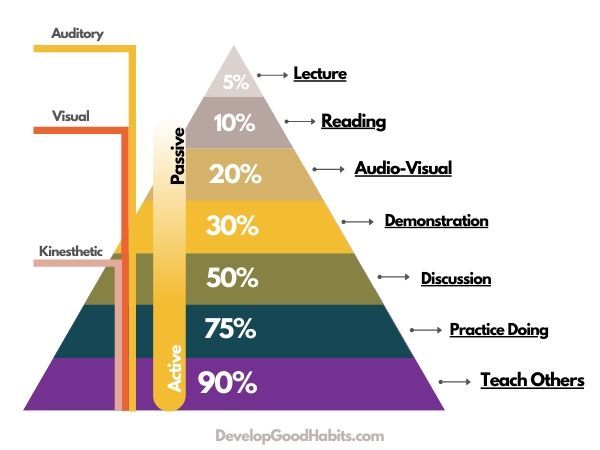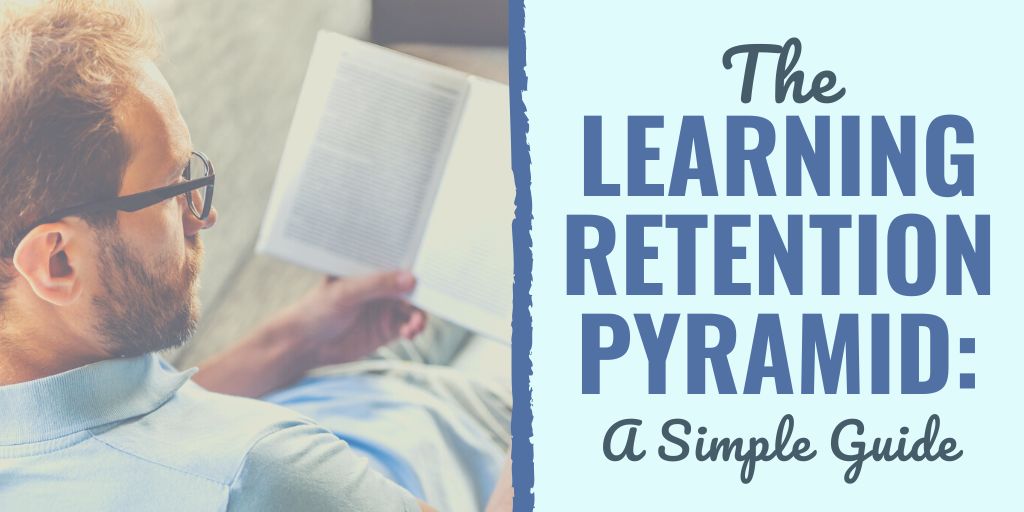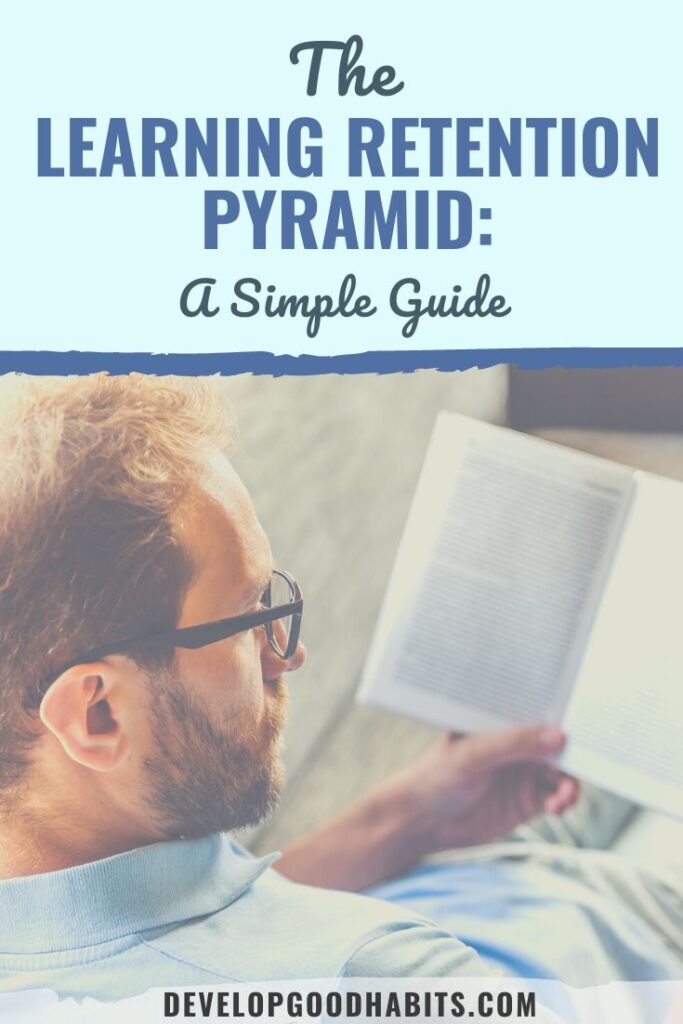There might be affiliate links on this page, which means we get a small commission of anything you buy. As an Amazon Associate we earn from qualifying purchases. Please do your own research before making any online purchase.
Have you ever heard the statistic that you only retain 5% of what you hear in a lecture?
If I’m honest, when thinking back to some of the classes I took in high school (I’m looking at you, history), I completely believe that this may be the case.
One factor that probably makes this statistic true is our extremely short attention spans. In fact, a study done by Microsoft in 2015 found that humans have an average attention span of only 8 seconds. Keep in mind that a goldfish’s attention span is 9 seconds.
So, while listening to lectures is by far the primary method of teaching in our educational system, it’s the least effective method for learning. A lot of students have a hard time understanding new concepts after only hearing about them in a lecture-type learning setting.
If this is the case, how are we supposed to retain the information that’s taught to us enough to recall it in the future? There’s no point in spending time learning things that are almost immediately forgotten.
This is where The Learning Retention Pyramid comes into play. This pyramid illustrates various methods of learning and how effective each one is when it comes to retaining the information that you’re learning.
In this article, we are going to define the Learning Retention Pyramid, discuss each level, and talk about how you can use this information in your life.
First, let’s look at what the Learning Retention Pyramid is.
What is the Learning Retention Pyramid?
The Learning Retention Pyramid is a theoretical model that illustrates the various methods by which one can learn and each method’s respective expected percentage of retention.
This concept illustrates how well you may be able to retain information based on the various methods that you can use to learn (i.e. listening to a lecture, reading a book, etc.).
Knowing about the Learning Retention Pyramid can help you gain a better understanding of how you can effectively comprehend new information that’s given to you.
The Learning Pyramid was originally created by the National Training Laboratories Institute during the 1960s, and while some have recreated it over time, the primary information from the original model remains the same.
This model posits that teaching information to others is the most effective way to learn it yourself, and the best way to make sure the material is stored in your long-term memory.
Here is a visual depiction of this model:

According to this graphic, here is the percentage of information you will retain based on the specific actions you’re taking:
While some have criticized the learning pyramid, the idea behind it remains in line with research that demonstrates that students can retain information more effectively if they do something rather than just hear it.
Taking an active approach to learning by interacting with other people or physically doing something related to the material is the best way to ensure you retain new information.
I’m sure if you think back to some instances in your life when you were learning something, you can recognize the relevance of this model.
For example, think about when you were learning to drive. You probably sat through many hours of lecture regarding the rules of the road, but were you ready to hop into the car and drive off after those classes?
Hopefully not…and that’s why driver’s ed includes a “behind the wheel” component to learning this skill.
Driving with an instructor allows students to practice doing the information that was taught in lectures so it can be recalled more easily in the future when students are driving on their own.
Let’s look a bit deeper at each level of this pyramid.
7 Levels of the Learning Retention Pyramid
1. Lecture
The Learning Pyramid shows that listening to a lecture is a passive way of learning, and is among the most ineffective ways to learn and retain new information.
Now, this can vary a bit from person to person. Trying to comprehend new material through lectures is difficult for many people, however, students who are auditory learners are better at learning through this teaching method than those who are visual or kinesthetic learners.
Here is an article that offers more information on the different styles of learning.
However, there are some things you can do to help you retain information presented in lectures a bit better than if you just sit back and listen.
You can make the most out of listening to a lecture by integrating another learning style into the process of listening, such as actively participating in any discussion that takes place and taking notes by hand.
One study conducted by researchers from UCLA and Princeton found that while typing notes on a laptop may be more convenient than writing them by hand, taking the extra step of physically writing new material helps students to not only retain more of the information, but also results in a greater understanding of the concepts being taught.
The researchers found that those who took handwritten notes were more likely to put the information into their own words (instead of writing it verbatim), which helped these students process and reframe the material in a way that made the most sense to them, which led to greater retention rates.
If you struggle to learn new things, then this video about 10 of the most powerful mind tricks can help. With just a few simple tweaks to your learning approach, you'll be able to pick up new skills in no time.
2. Reading
When compared to listening to a lecture, reading is marginally more effective when it comes to the likelihood that you will retain the information.
The advantage that reading has over listening to a lecture is that it provides you with reference material that you can go back to later to help you recall the material.
When you’re reading, you’re also able to highlight anything that stands out to you and take additional notes. However, this model still considers reading to be a relatively ineffective method of learning.
While reading does add in a visual piece that listening to a lecture doesn’t offer, you’re still absorbing new material in a passive way.
3. Audio-Visual
The Learning Pyramid indicates that learning through audio-visual methods will typically help you retain 20% of the information offered. This method of learning may integrate learning aids such as:
Audio-visual learning may include a lecture in addition to a series of visual aids, or as an individual instructional video. As time progresses and technology has evolved, innovative forms of audio-visual presentations have made it easier for students to retain new knowledge.
Like the other methods of learning on the Learning Retention Pyramid, audio-visual learning is most effective when it’s combined with other methods of learning that are more active.
4. Demonstration
Learning by demonstration involves observing a teacher showing students how to do something by walking them through a step-by-step process. As the teacher shows how to do the task, he or she simultaneously tells the students what they’re doing.
Demonstration is the first method of learning on The Learning Pyramid is considered to be “active”. Because demonstration often provides information in a more clear manner than passive study methods, it leads to a greater understanding–especially when information is vague or confusing.
Let’s say you’re learning how to fix a flat tire. If someone is telling you about this process but there isn’t a car present to allow them to show you what they’re talking about, you likely won’t be leaving the conversation anywhere near ready to start changing tires.
You need to watch someone actually do it so you can have a better idea of the process that they’re trying to explain to you.
5. Discussion
Discussions offer an active, cooperative learning environment that leads to a greater retention of information. This is the first form of kinesthetic learning on the Learning Pyramid.
Discussions don’t always look the same; they can take on a variety of forms. However, they always involve a collaborative, open-ended exchange of ideas to help:
Those participating in a discussion offer a variety of points of view, respond to others’ ideas, and engage in self-reflection to further their understanding or interpretation of a given subject.
A discussion may occur between two people, a small group, or a large group with a teacher or student leader. A discussion can focus on any subjective topic or issue that is based on a text, something in the media, a social justice issue, a societal norm, etc.
A defining factor of a discussion is the considerable agency that participants have in determining their own understanding or interpretation of the topic.
When participating in a discussion, students are able to decide for themselves if they agree with the credibility or validity of others’ responses, which requires comprehension and reflection on the information.
6. Practice Doing
Gaining “hands-on” experience is one of the most effective ways to learn. This method of learning allows you to apply what you’ve learned to everyday practice, which helps you be able to recall the information in the long-term.
When you practice doing something, it makes the information more meaningful, which also leads to a deeper understanding of it and a higher retention rate.
One way that technological advances have furthered opportunities to “practice doing” is through simulation. Simulated learning allows people to safely manipulate systems and then observe the impact of the change, which lets them receive immediate intrinsic feedback.
Cognitive tools such as these offer practical hands-on training to help learners practice and gain experience that they can then easily translate into real-world scenarios.
Research looking at brain scans of learners have shown that being able to physically experience a concept helps people retain new information.
Taking this hands-on approach to mastering a topic activates the areas of the brain associated with sensory and motor skills, which was later associated with an improved performance on tests.
Just-in-time learning makes good use of practice. The key to mastering a new skill is to only focus on the information that can be immediately applied. The video below shows an overview of just in time learning and the simple steps you can use to master any skill in a short amount of time.
7. Teach Others
The most effective way to master a subject is to teach it to others. If you can teach other people about a subject correctly, it means that you understand the concepts, you have a high retention for the information, and you’re able to easily recall it.
In a learning setting, this commonly takes the form of study groups or peer tutoring. It’s important to keep in mind that a critical component of learning by teaching is to internalize and comprehend the information before attempting to pass it onto others.
Learning by teaching is not effective if you’re simply relying on your notes as you’re presenting the material to others.
Learning by teaching is effective for many reasons, but one main reason is that as the teacher, you’re able to gain feedback from your student, which can help give you a new perspective and further enhance your own learning.
You get the opportunity to look at the information objectively and recognize any gaps in your own knowledge, which may prompt you to do further research.
Your students' questions can urge you to think about the material in different ways and require you to come up with unique ways of explaining it to help others who may have a different style of learning than you to understand it.
Further, watching students solve problems lets you see your knowledge being put directly into action.

How to Use the Learning Retention Pyramid in Your Life
Learning in today’s world looks very different than it did even just 10 or 15 years ago. Now, there are endless online courses available if you’re looking to learn a skill or obtain a degree, which leaves a lot of the learning process up to you.
When you take an online course, it’s your responsibility to figure out the best way for you to comprehend the information without having a teacher there to help answer your questions in real time.
The Learning Retention Pyramid shows that it’s safe to say that it’s not enough to simply listen to someone lecture you on a topic in a webinar if you’re really trying to learn about it.
You have to be interested in the topic enough to want to read additional related materials, review the PowerPoint slides after the webinar is over, highlight your notes, and come up with actions you can take to practice the skills right away in order to retain the new information.
This model also shows that practicing with someone else who is learning the same material that you are and exchanging feedback is a very effective method of storing new lessons in your long-term memory.
You have to be engaged in any learning process rather than sitting back and being a passive learner and expecting the information to stick. Taking the initiative to engage with any material is a critical part of retaining it.
This points out that a large barrier to remembering things isn’t the content or your brain’s capacity–it’s not new or unique information versus familiar information.
Rather, the greatest potential barrier to remembering something is your own sense of interest and engagement.
Final Thoughts on the Learning Pyramid
The best ways to learn anything well enough to be able to recall it in the future are toward the bottom of the Learning Retention Pyramid.
This model illustrates that actively participating in the learning process results in a greater ability to retain any new information.
However, this doesn’t mean that listening to lectures isn’t also important. Even if it's a challenge for you to recall information that is told to you in a lecture, your notes may end up being a critical component of your preparation for a discussion of the material later on, or a good resource to reference if you’re teaching the material to others.
It’s best if you can vary your study methods and incorporate a few of them in order to get the best long-term results.
Because being a life-long learner is so important these days, it’s best to make the best use of your time as you’re learning something by ensuring a high retention rate of new information.
It’s good to listen, but becoming engaged and gaining hands-on experience is better.
Now, if you're looking for some inspiration to start learning, check out these blog posts:
- 95 Education Quotes: Inspire Children, Parents, AND Teachers
- 103 Knowledge Quotes on the Importance of Always Learning
- 51 Growth & Fixed Mindset Quotes to Change Your Thinking
Finally, if you want to take your goal-setting efforts to the next level, check out this FREE printable worksheet and a step-by-step process that will help you set effective SMART goals.

Connie Mathers is a professional editor and freelance writer. She holds a Bachelor's Degree in Marketing and a Master’s Degree in Social Work. When she is not writing, Connie is either spending time with her daughter and two dogs, running, or working at her full-time job as a social worker in Richmond, VA.


